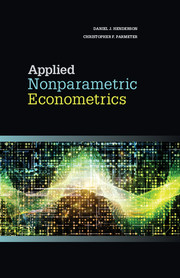Book contents
- Frontmatter
- Dedication
- Contents
- 1 Introduction
- 2 Univariate density estimation
- 3 Multivariate density estimation
- 4 Inference about the density
- 5 Regression
- 6 Testing in regression
- 7 Smoothing discrete variables
- 8 Regression with discrete covariates
- 9 Semiparametric methods
- 10 Instrumental variables
- 11 Panel data
- 12 Constrained estimation and inference
- Bibliography
- Index
4 - Inference about the density
Published online by Cambridge University Press: 05 February 2015
- Frontmatter
- Dedication
- Contents
- 1 Introduction
- 2 Univariate density estimation
- 3 Multivariate density estimation
- 4 Inference about the density
- 5 Regression
- 6 Testing in regression
- 7 Smoothing discrete variables
- 8 Regression with discrete covariates
- 9 Semiparametric methods
- 10 Instrumental variables
- 11 Panel data
- 12 Constrained estimation and inference
- Bibliography
- Index
Summary
Estimation of univariate and multivariate densities and examining their plots is of direct interest to practitioners. However, as is the case with a photograph, a thousand people viewing an estimated density may have a thousand different opinions on its shape. Therefore, it is imperative to conduct formal statistical tests for various phenomena of interest. In this chapter, we consider common and useful tests for both estimated univariate and multivariate densities.
Given that a correctly specified parametric model is efficient, it is important to test the nonparametric model versus a parametric alternative. For instance, if the density is normally distributed, it would be advantageous to exploit this fact when conducting an empirical analysis. For some economic problems, theory may provide information on the underlying distribution and hence this test could be used to validate theory with empirical data. Alternatively, this test can be used to test the assumptions other practitioners have used in the past. A test of interest for multivariate data is a test for joint normality. It is known that if two variables, say y and x, are jointly normal, then the conditional mean of y given x is linear. In other words, E (y|x = xβ. Hence, we can use this test to determine whether or not OLS would be an appropriate estimator in a regression framework.
In addition to the test for a correctly specified parametric distribution, we consider tests for equality between two unknown densities. This is common in the growth and development literature, where testing for equality of income densities of two different regions (Western and Central Europe), groups (WTO and non-WTO), or time periods is insightful. Another useful test in practice is that of symmetry around a particular point, most commonly zero. For example, in the nominal wage rigidity literature, symmetry of the wage-change distribution is key (e.g., Christofides and Stengos, 2001).
A test which requires multivariate data is the test for independence.
- Type
- Chapter
- Information
- Applied Nonparametric Econometrics , pp. 83 - 112Publisher: Cambridge University PressPrint publication year: 2015



